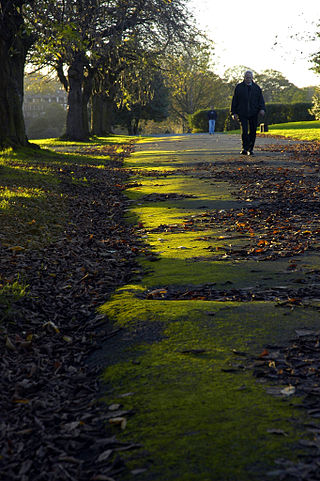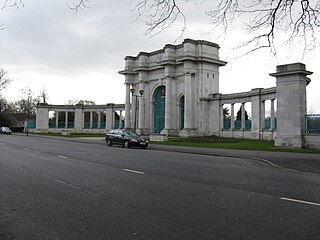
The Tower Hill Memorial is a pair of Commonwealth War Graves Commission memorials in Trinity Square Gardens, on Tower Hill in London, England. The memorials, one for the First World War and one for the Second, commemorate civilian, merchant seafarers and fishermen who were killed as a result of enemy action and have no known grave. The first, the Mercantile Marine War Memorial, was designed by Sir Edwin Lutyens and unveiled in 1928; the second, the Merchant Seamen's Memorial, was designed by Sir Edward Maufe and unveiled in 1955. A third memorial, commemorating merchant seamen who were killed in the 1982 Falklands War, was added to the site in 2005.

Capesthorne Hall is a country house near the village of Siddington, Cheshire, England. The house and its private chapel were built in the early 18th century, replacing an earlier hall and chapel nearby. They were built to Neoclassical designs by William Smith and (probably) his son Francis. Later in the 18th century, the house was extended by the addition of an orangery and a drawing room. In the 1830s the house was remodelled by Edward Blore; the work included the addition of an extension and a frontage in Jacobean style, and joining the central block to the service wings. In about 1837 the orangery was replaced by a large conservatory designed by Joseph Paxton. In 1861 the main part of the house was virtually destroyed by fire. It was rebuilt by Anthony Salvin, who generally followed Blore's designs but made modifications to the front, rebuilt the back of the house in Jacobean style, and altered the interior. There were further alterations later in the 19th century, including remodelling of the Saloon. During the Second World War the hall was used by the Red Cross, but subsequent deterioration prompted a restoration.

Beacon Park is a public park in the centre of the city of Lichfield, Staffordshire, in England. The park was created in 1859 when the Museum Gardens were laid out adjacent to the newly built Free Museum and Library. The park has since been extended in stages and now forms 69 acres (28 ha) of open parkland in the city centre. The park is in the northwest of the city centre and to the west of the Cathedral Close across the road from the Garden of Remembrance.

Armley Park is a large public park located next to Stanningley Road in Armley, on the outskirts of Leeds, in West Yorkshire, Northern England.

Charles Edward Bateman FRIBA was an English architect, known for his Arts and Crafts and Queen Anne-style houses and commercial buildings in the Birmingham area and for his sensitive vernacular restoration and extension work in the Cotswolds.

Minster Pool is a reservoir located between Bird Street and Dam Street in the heart of the city of Lichfield, Staffordshire in the United Kingdom. The pool lies directly south of Lichfield Cathedral and historically has been important to the defence of the Cathedral Close. The pool was originally formed in the 11th century when a boggy stream was dammed at its eastern end to drive a mill on Dam Street. The pool was used as a mill pond and fishery until 1856 when the mill was demolished; it has since been retained for public amenity.

The Nicholson War Memorial in Leek, Staffordshire, England is a 1925 war memorial. It was commissioned by local manufacturer Sir Arthur Nicholson and his wife Lady Marianne, née Falkner, in memory of their son Lieutenant Basil Lee Nicholson, who was killed in action at Ypres, Belgium, in 1915, at the age of 24; and in memory of all the other local men who died fighting in World War I. It now has plaques commemorating and naming 535 Leek and district men and women who died during World War I and World War II.

Lieutenant-Colonel Michael Alexander Wilsone Swinfen-Broun JP (1858–1948) was a soldier, magistrate, High Sheriff and Deputy Lieutenant of Staffordshire, and benefactor of the city of Lichfield, England, where he lived at Swinfen Hall.

The City War Memorial, Nottingham, also known as the Nottingham Municipal War Memorial and the City of Nottingham War Memorial, is the main war memorial for the city of Nottingham in England. It comprises a memorial arch of Portland stone with three openings and wrought iron gates, and stone flanking arcades. It was unveiled in 1927 beside a new park overlooking the River Trent, and became a Grade II listed building in 1972.

Southport War Memorial is in London Square, Lord Street, Southport, Merseyside, England. It consists of an obelisk flanked by two colonnades in the form of Greek temples. Outside the colonnades are memorial gardens, each containing a Pool of Remembrance and fountains. The memorial was designed by the local architects Grayson and Barnish, and the carving was executed by Herbert Tyson Smith. It was unveiled in 1923 by the Earl of Derby. Following the Second World War and subsequent conflicts further inscriptions and names have been added. The memorial is recorded in the National Heritage List for England as a designated Grade II* listed building.

The London Troops War Memorial, located in front of the Royal Exchange in the City of London, commemorates the men of London who fought in World War I and World War II.

Oldham War Memorial is a war memorial in Oldham, England, comprising a large bronze sculpture group on a granite plinth. It was built to commemorate the men of Oldham who were killed in the First World War. Bronze plaques on the wall of the churchyard nearby list the fallen, including Mabel Drinkwater, a nurse who died after an operation at Oldham Royal Infirmary. A mechanised roll of honour was added in the 1950s, listing the men from Oldham who were killed in the Second World War. The memorial became a Grade II listed building in 1973. The listing was upgraded to Grade II* in December 2016.

The York City War Memorial is a First World War memorial designed by Sir Edwin Lutyens and located in York in the north of England. Proposals for commemorating York's war dead originated in 1919 but proved controversial. Initial discussions focused on whether a memorial should be a monument or should take on some utilitarian purpose. Several functional proposals were examined until a public meeting in January 1920 opted for a monument. The city engineer produced a cost estimate and the war memorial committee engaged Lutyens, who had recently been commissioned by the North Eastern Railway (NER) to design their own war memorial, also to be sited in York.

The Lancashire Fusiliers War Memorial is a First World War memorial dedicated to members of the Lancashire Fusiliers killed in that conflict. Outside the Fusilier Museum in Bury, Greater Manchester, England, it was unveiled in 1922—on the seventh anniversary of the landing at Cape Helles, part of the Gallipoli Campaign in which the regiment suffered particularly heavy casualties. The memorial was designed by Sir Edwin Lutyens. He was commissioned in light of a family connection—his father and great uncle were officers in the Lancashire Fusiliers, a fact noted on a plaque nearby. He designed a tall, slender obelisk in Portland stone. The regiment's cap badge is carved near the top on the front and rear, surrounded by a laurel wreath. Further down are inscriptions containing the regiment's motto and a dedication. Two painted stone flags hang from the sides.
The Bank of England War Memorial, in the internal Garden Court at the headquarters of the Bank of England in the City of London, commemorates the bank's staff who were killed while serving in the First World War and Second World War. It includes a bronze sculpture by Richard Reginald Goulden portraying Saint Christopher carrying the Christ Child. It became a Grade II listed building in 2017. The surrounding buildings of the bank are separately listed at Grade I.

The City of Portsmouth War Memorial, also referred to as the Guildhall Square War Memorial, is a First World War memorial in Guildhall Square in the centre of Portsmouth, Hampshire, on the south coast of England. Portsmouth was and remains a port and home to a major naval dockyard. The dockyard and the armed forces provided much of the employment in the area in the early 20th century. As such, the town suffered significant losses in the First World War. Planning for a war memorial began shortly after the end of the conflict and a committee was established for the purpose. It selected a site adjacent to a railway embankment close to the Town Hall and chose the architects James Gibson and Walter Gordon, with sculptural elements by Charles Sargeant Jagger, from an open competition.

The Second Boer War Memorial lies in the city centre of York, in England.

The Burton upon Trent war memorial commemorates those from the town that were killed in the First and Second World Wars. The memorial was commissioned by the county borough of Burton upon Trent from sculptor Henry Charles Fehr shortly after the end of the First World War. The finished memorial was unveiled by William Legge, 6th Earl of Dartmouth on 2 August 1922. Its principal figure is that of Victory, standing atop a pedestal that is flanked by the smaller figures of Saint George and Peace. The memorial is a grade II* listed building.
Peter Walker is a British sculptor and artist who works in public art, monumental bronze and other materials, fine and installation art... His work consists of large-scale sculpture, commissioned and bespoke sculptural works, paintings, drawings and large-scale installations. Walker is a fellow of the Royal Society of British Artists, and a member of the Royal Society of Sculptors.


















